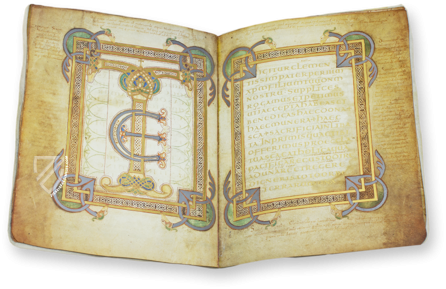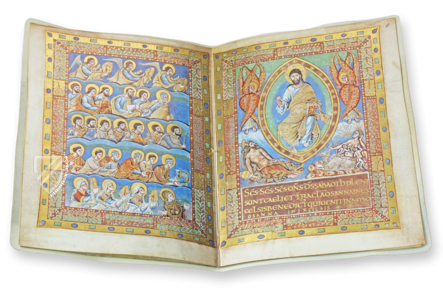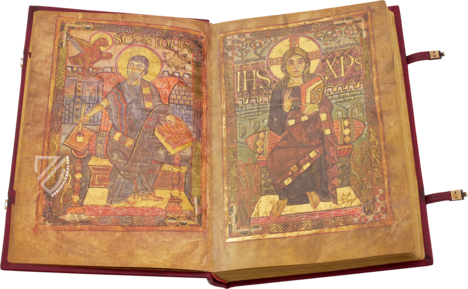Drogo Sacramentary
(1,000€ - 3,000€)
Charlemagne, the greatest monarch of medieval Europe, grandfather of the European Union, was a Frankish warlord who so greatly valued knowledge that he planted the seeds of the Renaissance with the numerous monasteries, scriptoria, and schools he established. He was also a human being with human appetites and as such had many children both legitimate and not. One of his illegitimate sons still became one of the greatest art patrons of the 9th century. Bishop Drogo. In addition to having his Cathedral in Metz embellished, he commissioned a number of manuscripts, the most outstanding of which is the Drogo Sacramentary. This manuscript is unique for many reasons ranging from its origins outside of a monastic scriptorium to the unusual and innovate nature of its figural depictions. The initials of the manuscript are absolutely fantastic and, like much of the text, are were created using luminous gold ink. All of this is part of a remarkably holistic and refined manuscript that reflects the sophistication of its patron.
The Drogo Sacramentary
Among the treasures of the Bibliothèque Nationale is a manuscript constituting one of the finest monuments of Carolingian illumination. It is a Sacramentary written and painted for Bishop Drogo’s personal use (823–855) and it has become a true monument to his name. Drogo, the illegitimate son of Charlemagne, was one of the greatest patrons of the arts in the 9th century. His fame as a great lover of the arts is not least based on the fact that he embellished his cathedral in Metz with the most sumptuous works which, in terms of beauty and preciousness, rank among the highlights of Carolingian art. Among them are three manuscripts, of which the Drogo Sacramentary is the latest and also most mature and most accomplished example.
One of the Most Perfect Carolinian Manuscripts
The Drogo Sacramentary is of a very personal character and was obviously produced outside a monastic scriptorium, unlike many other manuscripts made for export or for practical use in a religious institution. On the contrary, this work of art clearly is the production of a court school. The sacramentary reflects the individual, highly educated character of its patron, who hired artists and scribes to satisfy his own artistic ambitions. The manuscript was the result of teamwork between no more than two or three artists who united ornament, figurative portrayals and diverse types of script in a holistic composition, which still impresses us today with its uniquely beautiful and clear grading of the text.
The Initials
The ornamental decoration of the sacramentary boasts richly embellished initials in correlation with the text. When simply decorated, they consist of golden foliage and rinceaux winding around the body of the letter. The larger letters and sumptuous initial pages, however, are in direct reference to the contents of the text they precede. They depict incidents in the lives of Christ and the saints and are elaborately ornate with classical forms, such as vines, architectural elements and playing Eroses. In close relation with these initials are the ivory reliefs on the binding, which protect the original manuscript and are reproduced in the commentary volume of the facsimile edition. They repeat some of the scenes shown in the miniatures, including the same architecture and some persons in the same posture, wearing the same clothing.
An Important Work of Iconography
Of particular importance for the history of illumination and especially for iconography is the Easter Sunday initial depicting the Crucifixion (fol. 43v). This is the earliest example of a Crucifixion with a number of accompanying figures in Carolingian illumination. For the first time ever, two allegorical figures, representing the New and the Old Testaments, appear under the Cross. What strikes us here is that the Jewish religion is not depicted in a derogatory manner, as is often subsequently the case. On the contrary, the old man representing the Jewish religion relates positively to the scene, indicating the fulfilment of the Prophet’s word and his triumph over death, while Ecclesia as the allegory of the Christian Church collects the blood flowing from the wound in Christ’s side in a chalice. The chalice shown here for the first time as Ecclesia’s attribute goes back to purely Christian sources, whereas the hasta signifera, the lance with a flying banner as an ensign which Ecclesia holds in her left hand, goes back to antiquity and is a sign of sovereignty. Likewise, the disc that the old man holds in his hand, is a symbol of power. It represents the globe in a simplified sphere symbolizing the universe, which had been the attribute for world domination since the time of the Roman emperors.
A Masterpiece of Calligraphy
The liturgical text is written with great care in two types of script. The minuscule script used in the running text is complete with golden capitals, capitalis rustica, and uncials in all text divisions, thus not only highlighting single passages but also grading the importance of the text. The main portion of the Sacramentary, or Canon Missale (fol. 14r–21r), is enhanced with special ornament of extraordinary richness, with countless golden initials, figurative portrayals, and elaborate frames, the text written throughout in glowing golden letters.
Bishop Drogo’s Personal Sacramentary
The Sacramentary was not only destined for general use on all days of the Church year but also for the bishop’s personal use. It thus only contains those feast days on which the bishop himself celebrated Mass, as were prayers for the sacraments and solemnities recited by the bishop.
Codicology
- Alternative Titles
- Sacramentaire de Drogon
Drogo-Sakramentar - Size / Format
- 260 pages / 26.5 × 21.5 cm
- Origin
- France
- Date
- Ca. 850
- Epochs
- Style
- Language
- Illustrations
- 41 historiated initials with innovative scenes as well as numerous smaller decorative initials and ornamental text pages with gold ink
- Content
- Prayers and other texts to be recited by Bishop Drogo
- Patron
- Drogo, Bishop of Metz (823–855)
Drogo Sacramentary
Portrait of John the Evangelist
This green-gold “E” initial is an exemplary specimen of Carolingian art with tendril swirls and small medallion portraits embedded into the letter itself. Writing diligently at his desk, John is shown working on his Gospel as the Holy Spirit, represented by a white dove, fills him with divine inspiration. His symbol – an eagle with a halo – is perched on the middle “branch” of the historiated initial. The elegantly written text in gold ink further attests to the quality of this manuscript.

Drogo Sacramentary
Incipit Page: Canon of the Mass
This Carolingian manuscript is famous for its initials, a wonderful sampling of which is given on the present incipit page. It spells out the first word of the mass, CLEMENTISSME or “merciful”, in large, intricate initials worthy of its patron, a powerful bishop and illegitimate son of Charlemagne. The page nearly blinds the beholder due to the lavish application of gold leaf.
The letters are painted in either green or red, which were already expensive paints in their own right. However, one hardly notices these colors because of the primacy of gold leaf on the page. Although incorporating some Insular interlace patterns, the vines winding themselves around the letters are clearly in the style of the rinceaux found in Roman friezes.

#1 Das Drogo-Sakramentar
Languages: German, French
The commentary written by Wilhelm Koehler contains a general introduction and an insight into the history and making of the Sacramentary. It gives a short explanation of the compilation, decoration, and contents of the manuscript, and provides an overview of the secondary literature. Available in German or in French.
(1,000€ - 3,000€)
- Treatises / Secular Books
- Apocalypses / Beatus
- Astronomy / Astrology
- Bestiaries
- Bibles / Gospels
- Chronicles / History / Law
- Geography / Maps
- Saints' Lives
- Islam / Oriental
- Judaism / Hebrew
- Single Leaf Collections
- Leonardo da Vinci
- Literature / Poetry
- Liturgical Manuscripts
- Medicine / Botany / Alchemy
- Music
- Mythology / Prophecies
- Psalters
- Other Religious Books
- Games / Hunting
- Private Devotion Books
- Other Genres
- Afghanistan
- Armenia
- Austria
- Belgium
- Belize
- China
- Colombia
- Costa Rica
- Croatia
- Cyprus
- Czech Republic
- Denmark
- Egypt
- El Salvador
- Ethiopia
- France
- Germany
- Greece
- Guatemala
- Honduras
- Hungary
- India
- Iran
- Iraq
- Israel
- Italy
- Japan
- Jordan
- Kazakhstan
- Kyrgyzstan
- Lebanon
- Liechtenstein
- Luxembourg
- Mexico
- Morocco
- Netherlands
- Palestine
- Panama
- Peru
- Poland
- Portugal
- Russia
- Serbia
- Spain
- Sri Lanka
- Sweden
- Switzerland
- Syria
- Tajikistan
- Turkey
- Turkmenistan
- Ukraine
- United Kingdom
- United States
- Uzbekistan
- Vatican City
- A. Oosthoek, van Holkema & Warendorf
- Aboca Museum
- Ajuntament de Valencia
- Akademie Verlag
- Akademische Druck- u. Verlagsanstalt (ADEVA)
- Aldo Ausilio Editore - Bottega d’Erasmo
- Alecto Historical Editions
- Alkuin Verlag
- Almqvist & Wiksell
- Amilcare Pizzi
- Andreas & Andreas Verlagsbuchhandlung
- Archa 90
- Archiv Verlag
- Archivi Edizioni
- Arnold Verlag
- ARS
- Ars Magna
- ArtCodex
- AyN Ediciones
- Azimuth Editions
- Badenia Verlag
- Bärenreiter-Verlag
- Belser Verlag
- Belser Verlag / WK Wertkontor
- Benziger Verlag
- Bernardinum Wydawnictwo
- BiblioGemma
- Biblioteca Apostolica Vaticana (Vaticanstadt, Vaticanstadt)
- Bibliotheca Palatina Faksimile Verlag
- Bibliotheca Rara
- Boydell & Brewer
- Bramante Edizioni
- Bredius Genootschap
- Brepols Publishers
- British Library
- C. Weckesser
- Caixa Catalunya
- Canesi
- CAPSA, Ars Scriptoria
- Caratzas Brothers, Publishers
- Carus Verlag
- Casamassima Libri
- Chavane Verlag
- Christian Brandstätter Verlag
- Circulo Cientifico
- Club Bibliófilo Versol
- Club du Livre
- CM Editores
- Collegium Graphicum
- Collezione Apocrifa Da Vinci
- Comissão Nacional para as Comemorações dos Descobrimentos Portugueses
- Coron Verlag
- Corvina
- CTHS
- D. S. Brewer
- Damon
- De Agostini/UTET
- De Nederlandsche Boekhandel
- De Schutter
- Deuschle & Stemmle
- Deutscher Verlag für Kunstwissenschaft
- DIAMM
- Droz
- E. Schreiber Graphische Kunstanstalten
- Ediciones Boreal
- Ediciones Grial
- Ediclube
- Edições Inapa
- Edilan
- Editalia
- Edition Deuschle
- Edition Georg Popp
- Edition Leipzig
- Edition Libri Illustri
- Editiones Reales Sitios S. L.
- Éditions de l'Oiseau Lyre
- Editions Medicina Rara
- Editorial Casariego
- Editorial Mintzoa
- Editrice Antenore
- Editrice Velar
- Edizioni Edison
- Egeria, S.L.
- Eikon Editores
- Electa
- Emery Walker Limited
- Enciclopèdia Catalana
- Eos-Verlag
- Ephesus Publishing
- Ernst Battenberg
- Eugrammia Press
- Extraordinary Editions
- Fackelverlag
- Facsimila Art & Edition
- Facsimile Editions Ltd.
- Facsimilia Art & Edition Ebert KG
- Faksimile Verlag
- Feuermann Verlag
- Folger Shakespeare Library
- Franco Cosimo Panini Editore
- Friedrich Wittig Verlag
- Fundación Hullera Vasco-Leonesa
- G. Braziller
- Gabriele Mazzotta Editore
- Gebr. Mann Verlag
- Gesellschaft für graphische Industrie
- Getty Research Institute
- Giovanni Domenico de Rossi
- Giunti Editore
- Graffiti
- Grafica European Center of Fine Arts
- Guido Pressler
- Guillermo Blazquez
- Gustav Kiepenheuer
- H. N. Abrams
- Harrassowitz
- Harvard University Press
- Helikon
- Hendrickson Publishers
- Henning Oppermann
- Herder Verlag
- Hes & De Graaf Publishers
- Hoepli
- Holbein-Verlag
- Hortus Deliciarum
- Houghton Library
- Hugo Schmidt Verlag
- Idion Verlag
- Il Bulino, edizioni d'arte
- ILte
- Imago
- Insel Verlag
- Instituto Nacional de Antropología e Historia
- Istituto dell'Enciclopedia Italiana - Treccani
- Istituto Ellenico di Studi Bizantini e Postbizantini
- Istituto Geografico De Agostini
- Istituto Poligrafico e Zecca dello Stato
- Italarte Art Establishments
- J. Thorbecke
- Jan Thorbecke Verlag
- Johnson Reprint Corporation
- Josef Stocker
- Josef Stocker-Schmid
- Jugoslavija
- Karl W. Hiersemann
- Kasper Straube
- Kaydeda Ediciones
- Kindler Verlag / Coron Verlag
- Kodansha International Ltd.
- Konrad Kölbl Verlag
- Kurt Wolff Verlag
- La Liberia dello Stato
- La Linea Editrice
- La Meta Editore
- Lambert Schneider
- Landeskreditbank Baden-Württemberg
- Leo S. Olschki
- Les Incunables
- Library of Congress
- Libreria Musicale Italiana
- Lichtdruck
- Lito Immagine Editore
- Lumen Artis
- Lund Humphries
- M. Moleiro Editor
- Maison des Sciences de l'homme et de la société de Poitiers
- Manuscriptum
- Martinus Nijhoff
- Maruzen-Yushodo Co. Ltd.
- MASA
- McGraw-Hill
- Militos
- Millennium Liber
- Müller & Schindler
- Nahar and Steimatzky
- National Library of Wales
- Neri Pozza
- Nova Charta
- Oceanum Verlag
- Odeon
- Orbis Mediaevalis
- Orbis Pictus
- Österreichische Staatsdruckerei
- Oxford University Press
- Pageant Books
- Parzellers Buchverlag
- Patrimonio Ediciones
- Pattloch Verlag
- PIAF
- Pieper Verlag
- Plon-Nourrit et cie
- Prestel Verlag
- Princeton University Press
- Prisma Verlag
- Priuli & Verlucca, editori
- Pro Sport Verlag
- Propyläen Verlag
- Pytheas Books
- Quaternio Verlag Luzern
- Reales Sitios
- Recht-Verlag
- Reichert Verlag
- Reichsdruckerei
- Riehn & Reusch
- Roberto Vattori Editore
- Rosenkilde and Bagger
- Roxburghe Club
- Salerno Editrice
- Sarajevo Svjetlost
- Schöck ArtPrint Kft.
- Schulsinger Brothers
- Scolar Press
- Scrinium
- Scripta Maneant
- Scriptorium
- Shazar
- Siloé, arte y bibliofilia
- SISMEL - Edizioni del Galluzzo
- Sociedad Mexicana de Antropología
- Société des Bibliophiles & Iconophiles de Belgique
- Soncin Publishing
- Sorli Ediciones
- Stainer and Bell
- Studer
- Styria Verlag
- Sumptibus Pragopress
- Szegedi Tudomànyegyetem
- Taberna Libraria
- Tarshish Books
- Taschen
- Tempus Libri
- Testimonio Compañía Editorial
- Thames and Hudson
- The Clear Vue Publishing Partnership Limited
- The Facsimile Codex
- The Folio Society
- The Marquess of Normanby
- The Richard III and Yorkist History Trust
- Tip.Le.Co
- TouchArt
- TREC Publishing House
- TRI Publishing Co.
- Trident Editore
- Typis Regiae Officinae Polygraphicae
- Union Verlag Berlin
- Universidad de Granada
- University of California Press
- University of Chicago Press
- Urs Graf
- Vallecchi
- Van Wijnen
- VCH, Acta Humaniora
- VDI Verlag
- VEB Deutscher Verlag für Musik
- Verlag Anton Pustet / Andreas Verlag
- Verlag Bibliophile Drucke Josef Stocker
- Verlag der Münchner Drucke
- Verlag für Regionalgeschichte
- Verlag Styria
- Vicent Garcia Editores
- W. Turnowski Ltd.
- W. Turnowsky
- Waanders Printers
- Wiener Mechitharisten-Congregation (Wien, Österreich)
- Wissenschaftliche Buchgesellschaft
- Wissenschaftliche Verlagsgesellschaft
- Wydawnictwo Dolnoslaskie
- Xuntanza Editorial
- Zakład Narodowy
- Zollikofer AG

































































